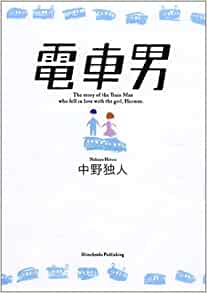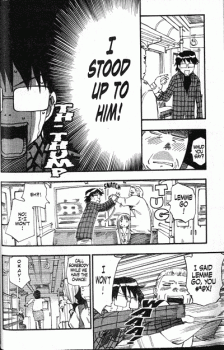After a wee bit of a hiatus, the manga blog is back in business! Although this is a terribly busy time for many people, I’d like to bring to your attention one of the most-read Japanese books since 2000 for your possible reading pleasure. Whether you pick it up now or later, this is a great choice to cozy up with after graduation season.

Densha Otoko (電車男) by Hitori
Nakano, PL873.5.A55 D46 2005
Hitori Nakano’s (中野独人) Densha Otoko (電車男), or “Train Man,” took Japan by storm in 2004. With its unique presentation and quirky plot, it quickly became a sensation across the nation. Densha Otoko details the efforts of our main character, the eponymous “train man,” to romance a woman with whom he had but a brief meeting with after an incident on a train commute. The catch? The train man has never been on a date and has no idea where to start.
If you’ve been on the internet at all over the last 20 years, you may know of 4Channel, or “4Chan.” What you may not know is that the anonymous message board was born out of its (at the time) slightly less problematic predecessor, 2ちゃんねる (ni-channeru), or “2Chan.” Herein lies the unique element of this love story: it plays out entirely over 2Chan. After the aforementioned train incident, in which our hero takes a risk to help several middle-aged women out when an old drunkard harasses them, he acquires the phone number of the one young woman also affected. Wanting to ask her to dinner but lacking any idea how to do this, he takes to 2Chan to share his story and romantic ineptitude. Surprisingly, the people of 2Chan begin to advise him on how to get a date, which quickly snowballs as he meets success. Soon, he is giving his 2Chan helpers progress updates as they continue to aid him toward maybe, just maybe, confessing his feelings for the girl…
Densha Otoko’s formatting is the main way it establishes the chat board atmosphere. Quite simply, it is designed to be a visual copy of a 2Chan board, complete with text boxes, timestamps, and “anonymous #X” with every post. But beyond formatting, it is steeped in early-2000s internet slang, for which the Japanese original has a very helpful glossary hiding under the front of the dust jacket. This book is truly a linguistic and visual treat. If you choose to read the Japanese version and are still just learning Japanese, it could pose some challenges due to how extremely colloquial it is. But do not despair! After getting used to the patterns and phrases, the reading becomes easier as you go.
Now, I know what you’re thinking: what does this have to do with manga? Well, I did say this was a cultural phenomenon, did I not? In fact, there have been so many adaptations of Densha Otoko that beyond the film and TV dramas there is not one, not two, but four manga adaptations! Each one has its own take on the story; one leans into the romance, while another leans more into the comedy. Not to mention the wildly varying art styles; you may want to read them all!
If you do, you’re in luck, because our very own collection has the original Japanese novel and two of the manga renditions in their entirety, with a third coming soon. You can ask about “電車男~でも、俺旅立つよ” at the Billy Ireland Cartoon Library, and “電車男:ネット発、各駅停車のラブ・ストーリー” is available from the book depository. Each of these manga series is three volumes total. The original novel, “電車男,” is available from Thompson Library. Should you prefer the English translation, you can find Train Man the novel at Thomson as well, or two of the manga versions at Billy Ireland if you ask: “Train Man: A Shojo Manga” and “Densha Otoko: the Story of the Train Man who Fell in Love with a Girl.”
Whether you’re interested in the internet culture side, the cute romance, or the positivity of internet anons being nice for once, give Densha Otoko a try. No matter what version or language you choose, you will not be disappointed.
Stay tuned for an announcement about a new donation to our manga collection, coming soon, and happy reading!




